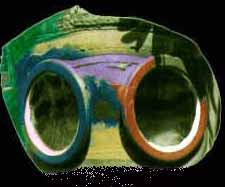Harold Jaffe
|
Harold Jaffe
As if potential year 2000 computer problems are not enough.Now stormy weather is predicted for the sun early next year, which, if true, would add to the torment of Earth's hyper-modern technology.
Researchers, using new techniques, are forecasting that the sun is about to enter the most violent and disruptive part of its 11-year cycle.
Which could mean celebrating the new millennium in the dark, without a cellular phone.
Which would of course create special problems for those living in high-crime areas.
Moreover, ships and planes relying on satellites for navigation would experience problems.
Even spacewalking astronauts are at risk.
As luck, or fate, would have it, the worst sun storm activity is expected to begin in January, just as computers around the world are struggling to cope with anticipated problems caused by the Y2K bug.
Severe solar storms erupting with massive bursts of magnetic energy and radiation are expected to continue at their peak until April.
Solar flares and coronal mass ejections--solar explosions that can equal a million 100 megaton bombs--send waves of energy toward Earth.
They can cause power blackouts, block radio communications and trigger phantom commands capable of sending satellites spinning out of their proper orbits.
Cellular telephones, global positioning signals and spacewalking atronauts are all at considerable risk, experts said yesterday at a national meeting of the Federal Y2K Commission, in Washington DC.
That is the bad news.
The relatively good news is that the solar cycle is not expected to be as severe as some in the past.
And, for the first time, there may be some warning, thanks to a government satellite that will detect bursts of solar energy and send about an hour's notice, said Lianne P. Jeremy of the National Oceanic and Atmospheric Administration.
That warning, posted on the Internet and relayed through a special system, will give power companies time to align circuits to minimize or avoid damage from electrical surges, she said.
Satellite operators can then power down equipment or prepare to send corrective signals to their spacecraft.
Scientists have plotted 23 solar cycles, using historic and modern measurements.
But the current cycle may be the most disruptive ever because much of the vulnerable communications technology now in use is new and has not been exposed to maximum solar activity, Jeremy said.
"The explosion in technology is coinciding with an extremely disturbed space environment," Jeremy said.
"There is much higher risk now because we depend more on technology that is vulnerable."
Jeremy said energy bursts from the sun can cause an electrical charge to build up on the surface of satellites, triggering phantom signals.
In an earlier solar cycle, she said, small rocket thrusters on a satellite suddenly started firing, sending the spacecraft out of position.
Control of another satellite was lost when its gyropscopes were disrupted.
Jeremy said cellular telephones are vulnerable because they may use the ionosphere--the region of electrically charged gases in the upper atmosphere--to send radio signals, and bursts from the sun can disturb the ionosphere.
2Anyone who wants to strike a city by spraying anthrax from a plane would need a crop duster with custom-built nozzles that could accomodate germ particles between 1 and 5 microns in size. Particles smaller than that would not have enough mass to float in the air properly.Larger particles would not be properly absorbed into the lungs.
To generate high casualties, the anthrax would have to be turned into freeze-dried anthrax, which can yield potencies of 100%. But freeze-drying requires complicated, costly equipment that can handle the spores in airtight containers.
Only government bio-weapon programs, such as Iraq's, are likely to have such equipment.
Anthrax is simpler to handle in a wet form called slurry. But the potency of this wet material is typically 10% to 15%.
Employing slurry, a low-tech terrorist could efficiently assault an institutional headquarters with a hand-held sprayer.
KWho then is the Antichrist?"It's Uncle Sam hiding behind the American flag, and all we can see are his devil-eyes," said Dewey Lester Blitz (pronounced "Blights"), who drove his red and white retrofitted church bus 1600 miles from Guthrie, Minnesota, to the nation's capital, arriving on the eve of the Millennium, to market his patented airtight canisters, called "Blighties," which, he claimed, will keep perishable food and beverages fresh and potable during the end of the world as we know it.
